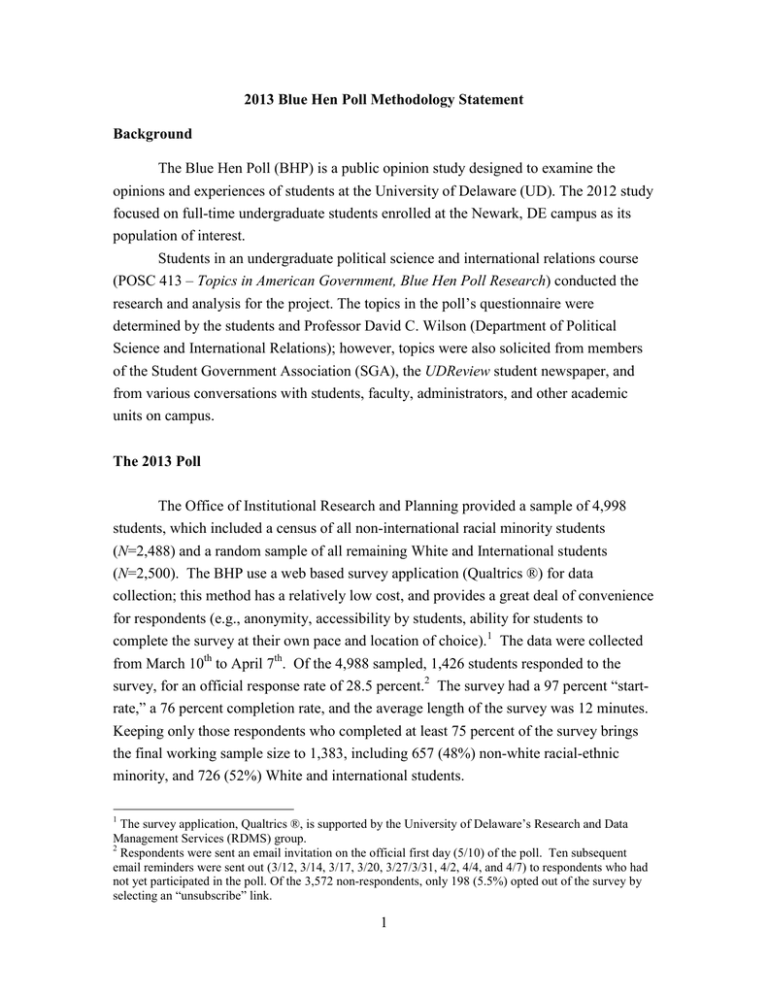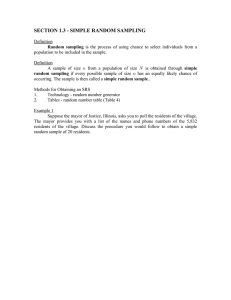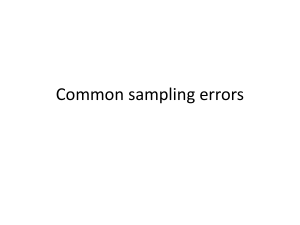The Blue Hen Poll (BHP) is a public opinion study... opinions and experiences of students at the University of Delaware... 2013 Blue Hen Poll Methodology Statement
advertisement

2013 Blue Hen Poll Methodology Statement Background The Blue Hen Poll (BHP) is a public opinion study designed to examine the opinions and experiences of students at the University of Delaware (UD). The 2012 study focused on full-time undergraduate students enrolled at the Newark, DE campus as its population of interest. Students in an undergraduate political science and international relations course (POSC 413 – Topics in American Government, Blue Hen Poll Research) conducted the research and analysis for the project. The topics in the poll’s questionnaire were determined by the students and Professor David C. Wilson (Department of Political Science and International Relations); however, topics were also solicited from members of the Student Government Association (SGA), the UDReview student newspaper, and from various conversations with students, faculty, administrators, and other academic units on campus. The 2013 Poll The Office of Institutional Research and Planning provided a sample of 4,998 students, which included a census of all non-international racial minority students (N=2,488) and a random sample of all remaining White and International students (N=2,500). The BHP use a web based survey application (Qualtrics ®) for data collection; this method has a relatively low cost, and provides a great deal of convenience for respondents (e.g., anonymity, accessibility by students, ability for students to complete the survey at their own pace and location of choice).1 The data were collected from March 10th to April 7th. Of the 4,988 sampled, 1,426 students responded to the survey, for an official response rate of 28.5 percent.2 The survey had a 97 percent “startrate,” a 76 percent completion rate, and the average length of the survey was 12 minutes. Keeping only those respondents who completed at least 75 percent of the survey brings the final working sample size to 1,383, including 657 (48%) non-white racial-ethnic minority, and 726 (52%) White and international students. 1 The survey application, Qualtrics ®, is supported by the University of Delaware’s Research and Data Management Services (RDMS) group. 2 Respondents were sent an email invitation on the official first day (5/10) of the poll. Ten subsequent email reminders were sent out (3/12, 3/14, 3/17, 3/20, 3/27/3/31, 4/2, 4/4, and 4/7) to respondents who had not yet participated in the poll. Of the 3,572 non-respondents, only 198 (5.5%) opted out of the survey by selecting an “unsubscribe” link. 1 Weighting the Data Weighting is generally used in survey analysis to compensate for sample designs and patterns of non-response that might bias results. The BHP sample was weighted to match UD’s full-time Newark campus student population parameters related to selected demographics. A two-stage weighting procedure was used to weight the BHP data. The first stage of weighting corrected for different probabilities of selection associated with the number of students in each racial-ethnic group.3 This is called the sampling weight, and it is equal to the reciprocal of the selection probability. If the selection probability is .05 (or 1/20 or 5%) then the weight would equal 20 (20/1, or “twenty over one”), which is akin to counting that observation twenty times in the sample. An element with a selection probability of .80 (or 8/10 or 80%), meanwhile, would only receive a weight of 1.25 (10/8 or “ten over eight”). The higher the weight, the more the group is taken into account in the analysis, and vice versa. The second stage of weighting balanced sample demographics to population parameters. Typically all cases count equally in a sample (weight =1), but when respondents are disproportionate to the population, adjustments are needed. This is known as the post-stratification weight, and it adjusts for biased response patterns among groups, or “strata.” For example, if only 45% of respondents were men (55% women), but the population actually contains 65% of men (35% women), then a new weight equal to the population proportion over the sample proportion. The weight for men would raise their presence in the statistics (.65/.45 = 1.44) and the weight for women would lower their presence (.35/.55 = .64). A single post-stratification weight was created to match UD population parameters for race-ethnicity, sex, academic class, and state residency (Delaware and non-Delaware). The sampling and post-stratification weights were combined to form a final weight, which is included in the dataset as the variable named weight. For accurate estimates and inferences using the BHP, the data must be weighted. Table 1 compares weighted and unweighted sample distributions to population parameters. 3 Racial-ethnic identification data came from the UD Office of Institutional Research. 2 Table 1. Blue Hen Poll Sample Demographics and their Distributions Weighted Unweighted Parameter Class Freshman Sophomore Junior Senior Total 21% 25% 23% 32% 100% 23% 26% 21% 30% 100% 21% 25% 23% 32% 100% Female Male Total 58% 42% 100% 64% 36% 100% 58% 42% 100% 77% 4% 3% 8% 0% 0% 7% 100% 52% 13% 9% 10% 0% 0% 15% 100% 77% 5% 3% 8% 0% 0% 5% 100% 99% 1% 100% 99% 1% 100% 95% 5% 100% 64% 36% 100% 57% 43% 100% 64% 36% 100% Gender Race-Ethnicity White Black Hispanic Asian HI/Pacific Islander American Indian Multi-racial Total International Status Non-International Status International Status Total Residency Status Non-Resident Resident Total * Race-ethnicity proportions are based on February 2013 enrollment. The Effects of having a Known Population Size Since the population of UD full-time undergraduate students is known, and relatively small compared to more commonly seen “national” samples, the errors associated with sampling can be adjusted by what is known as the finite population correction factor (FPC). 3 √ formula 1 With a population size (N) of 14,874, and a working sample size (n) of 1,380, the FPC for this study is .952. The FPC is multiplied by the standard error of proportion calculation, and becomes a part of the final margin of error estimate (see formula 3) for the study. The Effects of the Sampling Design The BHP employed a disproportionate stratified sampling design which increased the probability of racial minorities being selection. This requires that the sampling errors related to the BHP’s findings reflect our departure from a simple random sampling design—where each element (i.e., student) has the same probability of being selected. Such an adjustment is a multiplier to the margin of error called the "design effect" or deff, and it represents the loss in statistical efficiency that results from a disproportionate sample design and systematic non-response. The total sample design effect for the BHP is 1.33. The design effect for a given sample size (n), with each case having a weight, wi is: n deff n wi 2 i 1 wi i 1 n 2 formula 2 The design effect helps produce an adjusted margin of error for a statistic by multiplying the usual formula for the FPC corrected margin of error by the square root of the design effect (√deff). Thus, the formula for computing the 95% confidence interval around a percentage is: pˆ (1 pˆ ) FPC pˆ deff 1.96 n formula 3 where p̂ is the sample estimate and n is the unweighted number of sample cases in the group being considered. The deff and √deff are 1.30 and 1.14 respectively. 4 Margin of Error There are approximately 14,487 full-time undergraduate students enrolled at the University of Delaware (Newark, DE campus).4 For results based on 1,380 respondents, one can say with 95% confidence that the maximum error attributable to sampling (i.e., the “margin of error”) is 3%. In addition to sampling error, factors such as question wording and order, and other practical difficulties in conducting surveys can introduce some error or bias into the findings of public opinion polls. A live version of the BHP can be found at: https://delaware.qualtrics.com/SE/?SID=SV_8pozgeU6C7LVZyt 4 Fall statistics can be found at http://www.udel.edu/IR/fnf/enrol.html. 5






